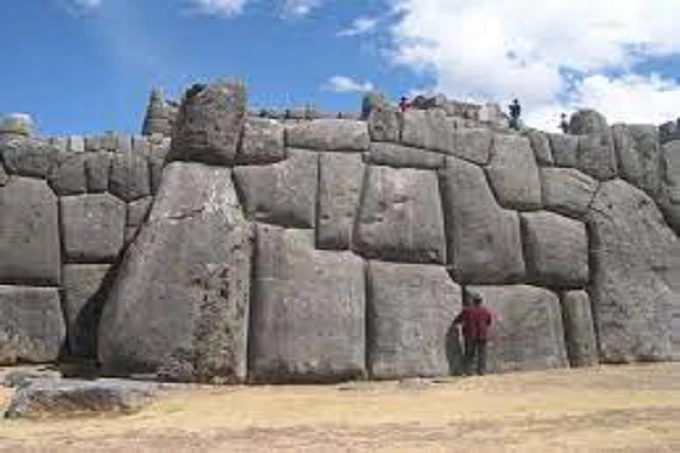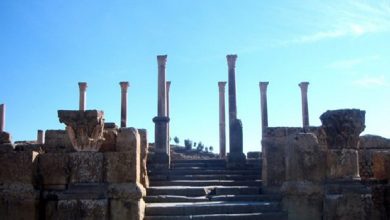The mighty Inca fortress of Sacsayhuaman

Sacsayhuaman (variable hawk), another enigmatic structure that is wrapped in numerous mysteries, may be found on the outskirts of Cusco, the ancient capital of the Incas. The fortress is protected on all sides by three walls measuring 1,500 feet in length and 54 feet in width. It is situated on a mountainside that has been artificially flattened. A circular stone structure that served as the great Incas’ solar calendar may be found in the exact middle of the fortification. In addition, there is a large water storage pool, storage barrels, citadels, and underground tunnels among the ruins.

The architectural skill of the Incas may be seen most clearly in the ruins of Sacsayhuaman, which are located in Peru. There are a lot of different explanations, some of which are pretty weird, for how these kinds of structures came to be. One of them claims that the Incas used the sap of plants to dissolve rocks. The Spaniards had the superstitious belief that the builders sought assistance from demons. Considering the various ideas, we can state one thing with absolute certainty: our ancestors had a great deal more information than previously believed.
It is a credit to Inca Pachacuti’s organizational abilities that the fortress of Sacsayhuaman, which is the biggest fortification in all of America, was built by him. The stronghold is constructed of perfectly aligned stones that are so strong that even cutting-edge machinery would have trouble moving them. Not only did the Incas get these huge blocks to the peak of the mountain, but they also constructed three walls with these stones. Nobody can determine for certain how the fortress was erected at this point. A few decades later, Pachacuti’s son, Huayna Capac, saw the completion of construction when he was already in power.

Each of the shafts has a length of 360 metres and is made up of 21 bastions. Some advancement has been made toward some of these bastions, while others have been withdrawn. The first fortress wall is the strong of the three. Stone blocks measure 9 metres in height, 5 meters in width, and 4 metres in-depth to make up this structure. The walls had many gates in the form of a trapezoid that could be secured with stone lintels. The fortress included three enormous towers that served as living quarters for the soldiers whose mission was to protect and defend Cusco. Their conquistadors demolished them quickly to prevent them from serving as a base for the Indians rebelling against the Spanish.

In addition to having an outstanding value from a military point of view, the stronghold was also used as a significant religious centre. The primary axes of the construction are formed by three zigzag walls that are parallel to one another. The material that is used to construct the inner structures and towers is brought in from a distance of 23 kilometres. A theory suggests the strange design of the walls of the fortress indicates that it was also a temple dedicated to the god of lightning at one point in its history. It has also been observed that the outlines of Cusco resemble the form of a cougar or puma and that the shape of the head of an animal also is seen in Sacsayhuaman.

One of the main structures in the fortress was likewise designed in the shape of a zigzag, which was meant to represent either a lightning bolt or the body of a snake. According to a local tradition, the warrior would put his fist into the “serpent’s skull,” which provided him “the power, bravery, and magical force to overcome enemies,” one of the writers stated. Before the writer got to this fortress and saw with his own eyes how the compass needle, which had been put in a depression in the wall, “began to whirl wildly, as if it had fallen under the sway of an unseen force,” the author did not believe in such tales. A common feature of sacred sites is the presence of unexplainable magnetism in its many manifestations. Studies in this field may likely explain some of the mysteries that have been posed and address some of the questions that have been presented from a scientific point of view.
Garcilaso de la Vega, a famous Quechuan-Spanish chronicler, once wrote of Sacsayhuaman:
This fortress surpasses the constructions known as the seven wonders of the world. For in the case of a long broad wall like that of Babylon, the colossus of Rhodes, the pyramids of Egypt, or the other monuments, one can see clearly how they were executed. They did it by summoning an immense body of workers and accumulating more and more material day by day and year by year. They overcame all difficulties by employing human effort over a long period. But it is indeed beyond the power of imagination to understand now these Indians, unacquainted with devices, engines, and implements could have cut, dressed, raised, and lowered great rocks, more like lumps of hills than building stones set them so exactly in their places. For this reason, and because the Indians were so familiar with demons, the work is attributed to enchantment.
As was just indicated, not every contemporary equipment can lift stone blocks of such a significant weight. Therefore, the most puzzling question is whether or not the Incas really constructed the fortress. Is it conceivable that Sacsayhuaman, like the well-known Nazca Lines, was built by a mysterious civilization that flourished a very long time before the rise of the Inca Empire?




